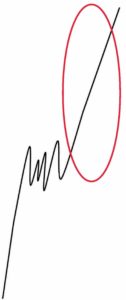Today we approach middle manager training from a higher altitude so that we can understand where it fits in to a basic paradigm: the natural journey of your business.
What is that natural journey for your business, exactly? We don’t know precisely what stage you currently reside in, but we can humbly offer that all natural systems follow a path of evolution – represented by the image below:
 What is the line communicating, and how does it relate to middle manager training? Let’s illustrate this by way of a story about the evolution of another natural system: a romantic relationship.
What is the line communicating, and how does it relate to middle manager training? Let’s illustrate this by way of a story about the evolution of another natural system: a romantic relationship.
A Typical Romance

The energy grows…
Imagine two people meet and quickly form a strong connection. Early in the relationship, the energy is incredible. The two feel a sense of timelessness, joy and well-being as they spend entire afternoons by the lake walking hand in hand. One sings and strums the guitar, as the other listens. They laugh and fall into silent awe, letting the conversation meander in the most delightful ways.
Weeks and months go by, drawing out the best in each. The energy between them seems to be growing by the day, with no imaginable end in sight.
And then something happens…
The Energy Dissipates

The energy dissipates
Conflict and friction enter the scene. The couple feels a sense of irritation, and the two find themselves quarreling. Trust issues, based on past relationships, seem to have worked their way into the couple’s interaction. Suddenly, the bliss, flow, timelessness and unbounded generosity of spirit have given way. The energy dissipates and grows unstable, entering a state of Entropy. The couple is lost for explanation as to how things could have changed so quickly.
Looking to restore the energy and feelings of the past, the two instinctively make attempts to repeat the activities that previously brought them so much joy and delight: the same dates, the same activities, the same thoughts, words, and deeds… but instead of harnessing the energy flow again, they can’t seem to get any traction. The reality is, the relationship (or system) has evolved, and what worked in the past may no longer be what the relationship needs.
At this moment, the couple faces a choice – try to ignore what they are feeling and recreate the past, or articulate a new vision that will provide a framework for them to engage as they move forward into a new, unknown reality.
If they choose the former, they will not address the real issues at hand, and will likely continue to lose energy in the relationship, and no longer grow together.
A New Trajectory – Returning to Growth
If, however, they choose to articulate a new vision, they will have something to aim for together. And to set out on that path, they can partner together to determine which elements in the relationship are working that they want to KEEP, which elements are not working that they want to DELETE, and which elements they want to CREATE NEW in order to add to the relationship. It is in this process that the couple can dig deep on their trust issues and together determine a new way forward, add energy to the relationship by entering a state of Syntropy, and once again grow as a team.
As it turns out, the evolutionary path that companies follow can be similar to romantic relationships
Business Was Booming
In 2001, the 20th Century Fox film studio began a period of incredible ascension. It was the first year of what became a string of eight record years – a period quite similar, in fact, to the ascension of the romantic relationship described above.
The studio at the time operated much like an Olympic relay team. Each high-performing division produced or distributed outstanding products or services, then handed the baton off to the next division in a linear sequence. Initially, Theatrical Production produced the film and passed it to Theatrical Marketing and Distribution. Once the film launched in theaters, Theatrical Marketing and Distribution passed the baton to Home Entertainment, which in turn passed it to TV Distribution. The company was operating on all cylinders not only with film launches, but also with the sale of library titles on DVD, and everyone at the company was winning.
The Company ran its businesses as well-oiled machines on a tightly orchestrated assembly line. Each division was great at making its area the best in the industry. Leadership within each division tended to the needs and prerogatives of its own business – which presented few challenges because the organization, people, and processes were arranged ideally for the existing marketplace.
Most notably, since business was booming, there was no compelling need to significantly alter the process. Little of the work produced in a single division impacted the perspectives or needs of the other divisions. The people of Fox took incredible pride in their work, and the successful performance of their creative outputs in the marketplace.
Waking Up In A New Volatile Marketplace – Entropy Enters the Scene
The release of Avatar in 2009 was the gem in the crown of the ascent Fox started in 2001. Profits on the film broke all-time records, company morale was high, and it seemed Fox was positioned to take on vistas no one could have imagined just a few short years before. However, at the peak of the growth, circumstances suddenly changed.
2008 was a year of incredible disruption, beginning with the commencement of the Great Recession. DVD piracy was rampant, affecting the entire marketplace – not only in the form of illegal hard copies from Asia, but also in the form of torrent downloads and new forms of digital delivery that lawmakers were struggling to categorize properly. But that wasn’t all. True video on demand (VOD) rental was also beginning to resonate. Consumers could now have movies and television shows delivered directly into their homes through an internet connection with the simple click of a button – and no amount of discount DVD bins at WalMart was going to change that.
The industry turned much of its focus to the electronic sale of movies and tv shows, but consumers had no confidence in the reliability of digital lockers for storing their electronic video assets.
In the DVD category alone, the entire film and television industry began to witness an ongoing decline in profits, with no indication that things would return to prior peak levels. The movie industry’s old way of doing business was no longer as profitable.
A confluence of factors very quickly brought Fox leadership to reassess the entire way it approached the business.
Creating Alignment To Overcome The Plateau
Fox Sets Brave New Course
Like the couple who aligned around a shared new vision, Fox leadership knew there was no way of winning in the new marketplace following yesterday’s playbook. The studio leadership knew it needed to align around a new vision.
Prior to the turbulence, each studio division was able to navigate its respective territory without concern over its impact on the other divisions. The growth in the business had been substantial in all areas, so there had been plenty of room for each business to grow. Moving forward, though, that was no longer going to be the case.
In order to drive profitability across the company as a whole, each division needed to further understand the impact of its actions on the other areas. This necessitated a change in the culture of the company. Moving forward, it would be critical to ensure that the organization, people and processes were structured to foster a greater level of open, horizontal communication across the various vertical operating divisions. The vision for the company culture became a focal point for the future:
To create an open and collaborative culture where creativity and innovation thrive.
Leadership set out on a new path. It pulled senior management together, then held a town hall to communicate with the entire employee base. The message was clear – more than ever, the company needed to operate as a single unit.
Keep – Delete – Create New
The studio hosted workshops for all levels of employees, so that everyone would focus more on the impact to other divisions of their own division’s decisions and approach. Middle manager training was a key focus because that group would play a key role in driving day-to-day collaboration across the enterprise, enabling each division to do its work with input and robust communication from all sides of the business.
The studio assessed what aspects of its culture were working that it wanted to KEEP, which approaches and mindsets it needed to DELETE, and what other elements it needed to CREATE NEW to ascend on its new Syntropic growth trajectory.
Through the process, studio leadership also learned it needed to create two new divisions focused on connecting the studio’s vertical businesses – brand management and consumer engagement – in order to maintain a broad focus over the full life-cycle of the studio’s intellectual property.
Implementing The Common Vision
Employees undergoing the middle manager training that has since become Hallett Leadership’s Accelerated Leadership Program, were at the tip of the spear for implementing the new Fox vision companywide. Prior to the disruption in the industry, Fox brought together managers from every part of the company, and trained them in nine-month cohorts – in both the theory and the application of high performance, collaborative leadership.
These middle managers had already integrated high-performance leadership techniques into their daily routines. As a result the were prepared to champion the new culture, and were key catalysts in working to identify what organizational structure, personnel development and operating processes would be essential to support and maintain the new studio approach. Through this new approach, work outputs reflected the needs, realities, and highest good of the entire business given the new marketplace realities – driving a new stage of profitability and upward ascension.
People dove into their work with enthusiasm and a collaborative spirit – devising products, work flows, and solutions that were better collectively than any single individual or department would have been able to produce.
CONCLUSION
Our story ends with both the couple and the Fox studios setting out re-energized on a new path for growth. Each took a step into an uncertain future by decisively letting go of the past and aligning around a common future.
If you are still wondering how this pertains to middle manager training, we would clarify it this way: whatever common vision your group aligns around when growth stagnates, it is not only senior leadership that can initiate a cultural shift toward collaboration. Middle managers have significant levels of influence in an organization and, when trained properly in the art of collaborative leadership, are capable of providing an organization with the greatest chance of engaging a new upward trajectory.
In the process of middle manager training, keep in mind the basic premise: all natural systems follow a predictable path of evolution. So, develop your middle managers into champions now, and when you find your organization in the midst of Entropy, align around a common future, and empower your middle managers to lead the way.
Wishing you and your people the best of luck.






